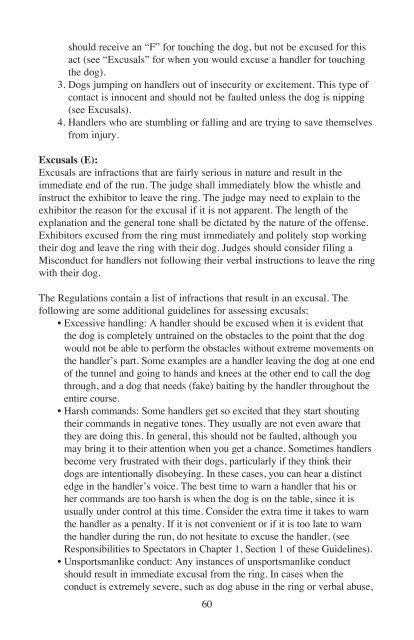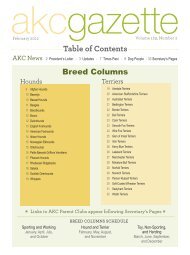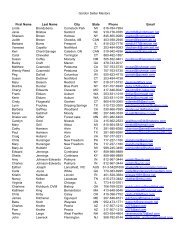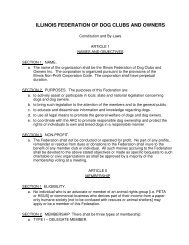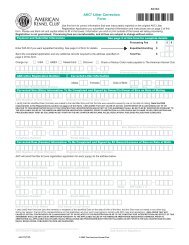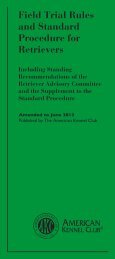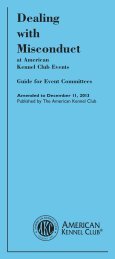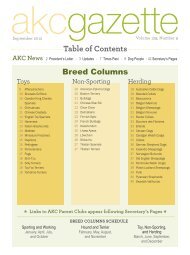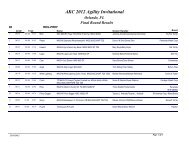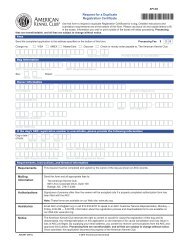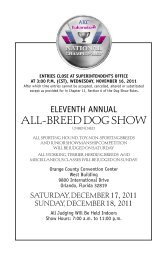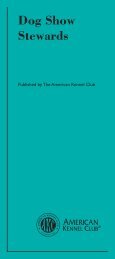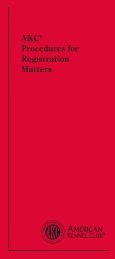You also want an ePaper? Increase the reach of your titles
YUMPU automatically turns print PDFs into web optimized ePapers that Google loves.
should receive an “F” for touching the dog, but not be excused for this<br />
act (see “Excusals” for when you would excuse a handler for touching<br />
the dog).<br />
3. Dogs jumping on handlers out of insecurity or excitement. This type of<br />
contact is innocent and should not be faulted unless the dog is nipping<br />
(see Excusals).<br />
4. Handlers who are stumbling or falling and are trying to save themselves<br />
from injury.<br />
Excusals (E):<br />
Excusals are infractions that are fairly serious in nature and result in the<br />
immediate end of the run. The judge shall immediately blow the whistle and<br />
instruct the exhibitor to leave the ring. The judge may need to explain to the<br />
exhibitor the reason for the excusal if it is not apparent. The length of the<br />
explanation and the general tone shall be dictated by the nature of the offense.<br />
Exhibitors excused from the ring must immediately and politely stop working<br />
their dog and leave the ring with their dog. <strong>Judges</strong> should consider filing a<br />
Misconduct for handlers not following their verbal instructions to leave the ring<br />
with their dog.<br />
The Regulations contain a list of infractions that result in an excusal. The<br />
following are some additional guidelines for assessing excusals:<br />
• Excessive handling: A handler should be excused when it is evident that<br />
the dog is completely untrained on the obstacles to the point that the dog<br />
would not be able to perform the obstacles without extreme movements on<br />
the handler’s part. Some examples are a handler leaving the dog at one end<br />
of the tunnel and going to hands and knees at the other end to call the dog<br />
through, and a dog that needs (fake) baiting by the handler throughout the<br />
entire course.<br />
• Harsh commands: Some handlers get so excited that they start shouting<br />
their commands in negative tones. They usually are not even aware that<br />
they are doing this. In general, this should not be faulted, although you<br />
may bring it to their attention when you get a chance. Sometimes handlers<br />
become very frustrated with their dogs, particularly if they think their<br />
dogs are intentionally disobeying. In these cases, you can hear a distinct<br />
edge in the handler’s voice. The best time to warn a handler that his or<br />
her commands are too harsh is when the dog is on the table, since it is<br />
usually under control at this time. Consider the extra time it takes to warn<br />
the handler as a penalty. If it is not convenient or if it is too late to warn<br />
the handler during the run, do not hesitate to excuse the handler. (see<br />
Responsibilities to Spectators in Chapter 1, Section 1 of these <strong>Guidelines</strong>).<br />
• Unsportsmanlike conduct: Any instances of unsportsmanlike conduct<br />
should result in immediate excusal from the ring. In cases when the<br />
conduct is extremely severe, such as dog abuse in the ring or verbal abuse,<br />
60


